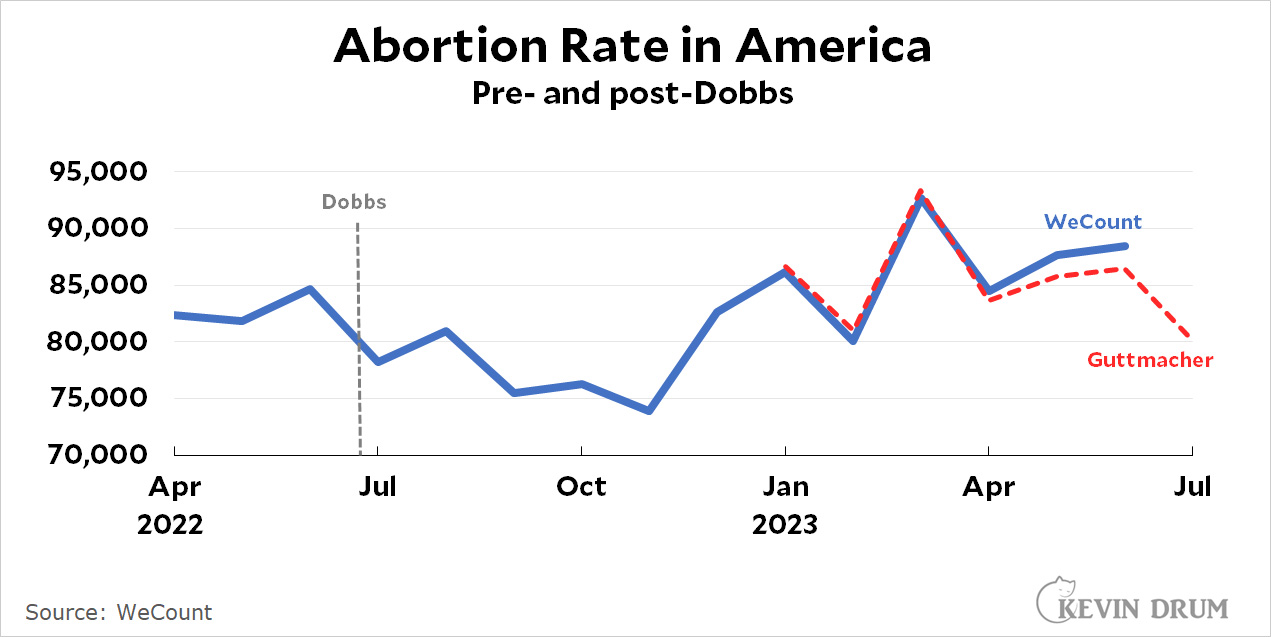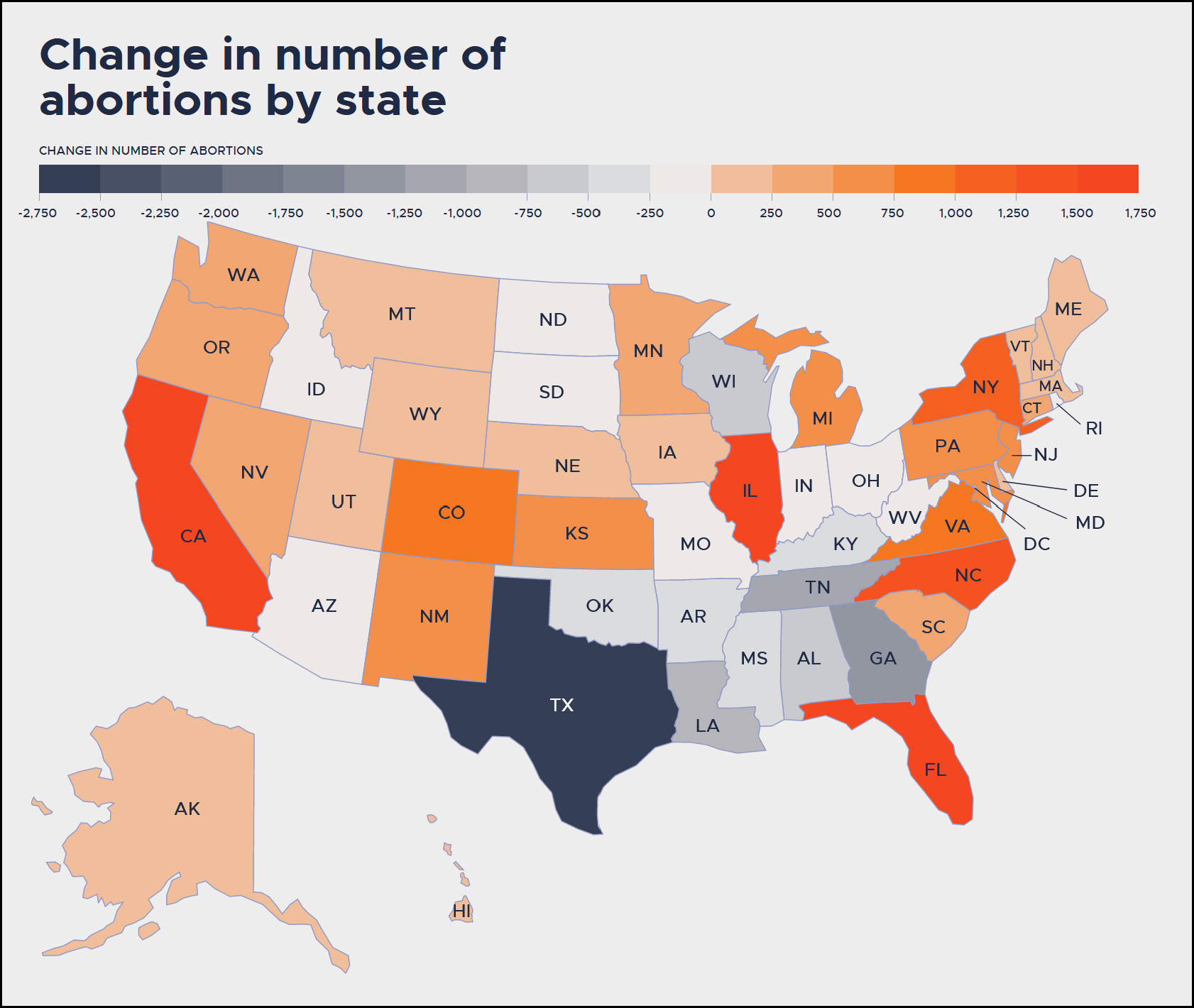According to WeCount—not to be confused with WeCount! or We Count or Wecount—abortions declined in the five months following the Dobbs decision but then started rising. The abortion rate today is higher than it was before Dobbs:
 The reason for this is obvious: abortions went down in states that banned them but went up in other states as women traveled out of state to obtain abortions:
The reason for this is obvious: abortions went down in states that banned them but went up in other states as women traveled out of state to obtain abortions:
 The WeCount numbers include all abortions provided via the formal health care system, including telehealth and medication abortions.
The WeCount numbers include all abortions provided via the formal health care system, including telehealth and medication abortions.
The WeCount project is sponsored by the Society for Family Planning, which doesn't have a long track record of counting abortions. So I don't know how accurate it is. Their numbers match fairly well through June with those from Guttmacher, which has more experience in the counting business, but note that Guttmacher doesn't show any overall increase in 2023. So take this all with a grain of salt.

For those interested in a better analysis of the situation check out LGM’s post from earlier today and read the comment section for some additional analysis.
Kevin Drum wrote “The abortion rate today is higher than it was before Dobbs: The reason for this is obvious: abortions went down in states that banned them but went up in other states as women traveled out of state to obtain abortions:”
What does the word obvious mean in Drum’s world? If people are doing the same thing, but only moving the location to a different state, then that would explain if the national numbers stayed the same. The fact that they went up most likely signifies something else. My explanation is that clinics that were performing abortions were also helping with other forms of family planning and women’s health which includes contraception. If you don’t have available or affordable access, then one is more likely to have a pregnancy that one doesn’t want. This is another factor in the reason that maternal mortality has been rising for 2 decades. There are many other factors, but all the trap laws create obstacles that force women to have pregnancies that are more dangerous if they could have had an abortion earlier in the process. This rarely got mentioned before the Dobbs decision.
This was the 1068th installment in “white guy in Orange County has some thoughts about an issue that doesn’t really impact him, and it’s not that serious in his estimation or he can’t be bothered to research it more than 20 minutes” series.
For anyone interested in the link to LGM here it is.
https://www.lawyersgunsmoneyblog.com/2023/10/dobbs-has-not-reduced-total-abortions-in-the-usa
I personally suspect that pre-Dobbs, there were "hidden abortions" happening in red states with strict TRAP laws. With abortion clinics regulated to the point that they were few and far between, sympathetic PCPs and OB-GYNs were probably prescribing misoprostol and performing D&Cs on false pretenses to fill the need, figuring that they were unlikely to get caught and unlikely to face serious consequences even if they were. This caused abortions in red states to be undercounted.
Post-Dobbs, abortion was outright criminalized in those states, and these "sly providers" weren't willing to risk it anymore. Patients had to go out of state, where their abortions were duly recorded.
That could account for some of the increase, but TRAP laws have been around for over 30 years. It has been grinding down the infrastructure and medical community methodically and relentlessly. I have read people from the south periodically write about how they have moved or stopped doing what you describe prior to Dobbs. For instance, they were doing it a decade ago, but stopped 2 years ago. They were getting scared or saw the writing on the wall.
“From 2000 to 2008, the number of abortion facilities in the United States remained relatively constant at approximately 1800 and then decreased somewhat to 1720 by 2011.1 However, since 2011, 162 facilities have closed while only 21 have opened. A potential important factor leading to the closing of abortion facilities during this time is state targeted regulation of abortion providers (“TRAP”) laws that require clinics to meet certain conditions to operate. As of 2016, 28 states had enacted restrictions on abortion facilities, the clinicians, or both.”
I don’t think most people realize how bad it was getting the decade before the Dobbs decision.
“From 2004 to 2014, the overall abortion rate in Texas fell by almost a third from 10.7 to 7.2 abortions per 1000 women aged 10 to 49 years. During this same period, the number of abortion clinics operating at least 6 months in the year fell from 40 to 27.”
https://www.ncbi.nlm.nih.gov/pmc/articles/PMC5798726/
I believe that figure of 27 was from 2014. Rachel Maddow did a report a few years ago, that over the previous 2 years the number of abortion clinics that were still operating went from 8 to 5 to 3 in Texas the year before the Dobbs decision.
That link is really good if you want to look at abortion on the state level. The entire decline was in regions that no longer had a clinic within 100 miles. Of that number most of it was in regions that were more than 200 miles from a clinic. I am sure they were getting helped like your comment pointed out or going to another state, so those abortions were not counted. However, some of those women died that previously would have had an abortion, then were designated maternal mortality deaths.
“The maternal mortality rate for 2021 was 32.9 deaths per 100,000 live births, compared with a rate of 23.8 in 2020 and 20.1 in 2019.”
https://www.cdc.gov/nchs/data/hestat/maternal-mortality/2021/maternal-mortality-rates-2021.htm#:~:text=The%20maternal%20mortality%20rate%20for,20.1%20in%202019%20(Table).
The maternal mortality rate in the U.S. for 2018 was 17.4 maternal deaths per 100,000 live births. This rate is higher than the last time NCHS published a national rate (12.7 in 2007), but the increase in the maternal mortality rate largely reflects changes in the way the data was collected and reported.
https://www.cdc.gov/nchs/pressroom/nchs_press_releases/2020/202001_MMR.htm
Obviously with the different data reporting differences the comparison to the latest figures and 2007 is not an apples to apples comparison, but the TRAP laws were already having an effect and the media refused to ever mention this impact.
Agreed that KD’s explanation isn’t one. Unless there is more to it than he describes. The whole thing should net out to zero.
A civilization that does not value new life is a civilisation in decline.
How does a telehealth abortion work?
It has to be a medication abortion. The pills get mailed to the patient and the provider assesses them and gives them instructions via video call.